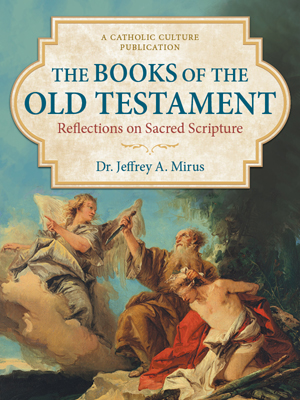The Light of the World and Ritual Mutilation
By Fr. Jerry Pokorsky ( bio - articles - email ) | Feb 06, 2023
Jesus teaches: “You are the light of the world. A city set on a hill cannot be hid. Nor do men light a lamp and put it under a bushel, but on a stand, and it gives light to all in the house. Let your light so shine before men, that they may see your good works and give glory to your Father who is in heaven.” (Mt. 5:14-16)
Thoughtful Catholics easily grasp the path to holiness. Express an unshakable belief in the Creed. Evaluate thoughts, words, deeds, and omissions by the Ten Commandments. Encounter Jesus in prayer and the Sacraments.
We are members of the Mystical Body of Christ. “If one member suffers, all suffer together; if one member is honored, all rejoice together.” (I Cor. 12:26) We are the “light of the world” and give glory to God with the communal celebration of Mass. (So much for live-streaming!)
The Mass is like a cluster of candles with the Paschal Candle in the center. The Real Presence glows from the Easter Candle with Catholics—in the state of grace—absorbing and reflecting the Light.
With the ritual exchange of generosity we freely enter into the new and eternal Covenant that culminates in the Body, Blood, Soul, and Divinity of Jesus in Holy Communion, with our “Amen” ratifying our part of the bargain. (There is no hint of servile pagan appeasement—we crucified God, not the other way around.)
The Liturgy of the Word
- We acknowledge our presence before God with the Sign of the Cross.
- We immediately express sorrow for our sins.
- We give glory to God.
- We listen to His Word.
- Reciting the Creed, we affirm our unconditional belief in Jesus and the authentic teachings of the Church.
Transitioning to the Sacred Mysteries
- With faith, we dare to ask for His favors in the Prayers of the Faithful.
- We generously offer our lives, symbolized by bread and wine, the work of human hands.
Continuing the Liturgy of the Eucharist
- We accompany Jesus as He enters Jerusalem and as we chant the Sanctus.
- We mystically stand at the foot of the Cross during the Consecration during the unbloody representation of the one Sacrifice.
- We bundle all our prayers in Jesus as we pray: “Through Him, with Him, and in Him....”
- In Jesus, we dare to address the Father directly: “Our Father….”
- God responds to our generosity with infinitely perfect generosity. We receive Holy Communion as individuals and in union with the entire Mystical Body of Christ, living and dead.
- Jesus sends us out as living lights to live and proclaim the Gospel.
How can we go wrong? Yet we do.
On the part of the priest
A validly ordained priest enkindles the candle of the Real Presence when he offers Mass according to the mind of the Church, with the intention of Jesus through His Church. Without a validly ordained priest, his proper intent, and vigilance in honoring the essentials of the Mass-—our candles flicker (an illicit Mass) and fail (an invalid Mass).
Too often the narcissism of the priest smothers generosity and eclipses the light of Christ. The priest extinguishes a few candles when he tinkers with the Mass: changing the lawful words of the Mass, introducing alien gestures, or glad-handing in processions. A valid and licit Mass depends upon the priest and his resolve to follow the example of John the Baptist: “He must increase, but I must decrease.” (Jn. 13:30)
Celebrating Mass ad orientem—figuratively facing east, anticipating the Second Coming of Jesus as he leads the people in prayer—reduces the opportunities for his narcissism. Mass versus populum is lawful and far more common today but requires the effort to avoid the absurdity of clerical celebrity narcissism. “Father, it’s not about you!”
On the part of the people
Families give us priests. The laity and clergy alike often yearn for entertainment rather than worship. Usually encouraged by priests, we have seen an array of liturgical absurdities (e.g., liturgical dance) and a demand for innovations, including the new secular religion of “diversity, equity, and inclusion.”
Authorities often give up and permit violations without correction: Pope Paul VI (Communion in the hand), Pope John Paul II (altar girls), and Pope Francis (Holy Thursday washing of women’s feet). Such violations can become widespread, and eventually become officially accepted, encouraging further unauthorized experimentation.
Growing demand for the stability of the Extraordinary Form suggests widespread disgust with the unholy manipulation of Masses and the failure to abide by this directive: “Finally, there must be no innovations unless the good of the Church genuinely and certainly requires them; and care must be taken that any new forms adopted should in some way grow organically from forms already existing.” (Vatican II, SC 23)
How do we increase the lumen brightness of the Mass?
Simple. Mass is like going atop Mount Tabor, where the divine radiance shines through earthly matter. The Church teaches, “Let the rites shine with [or radiate] noble simplicity” (SC 34). The glow of the Mass allows the people (like Peter, James, and John) to soak up the divine radiance through humble cooperation as we receive Him with joyful hearts. The priest (and people) shouldn’t eclipse or dim the brilliance through ritual mutilation.
Jesus doesn’t need the cluster of our lights to enhance His glory; He chooses to need us. The salvation of our souls, family, and the world depend upon Jesus—and us as members of His Body.
The Mass continues without interruption for eternity: “Holy, Holy, Holy Lord God of hosts. Heaven and earth are full of your glory.”
“You are the light of the world. A city set on a hill cannot be hid.”
All comments are moderated. To lighten our editing burden, only current donors are allowed to Sound Off. If you are a current donor, log in to see the comment form; otherwise please support our work, and Sound Off!








